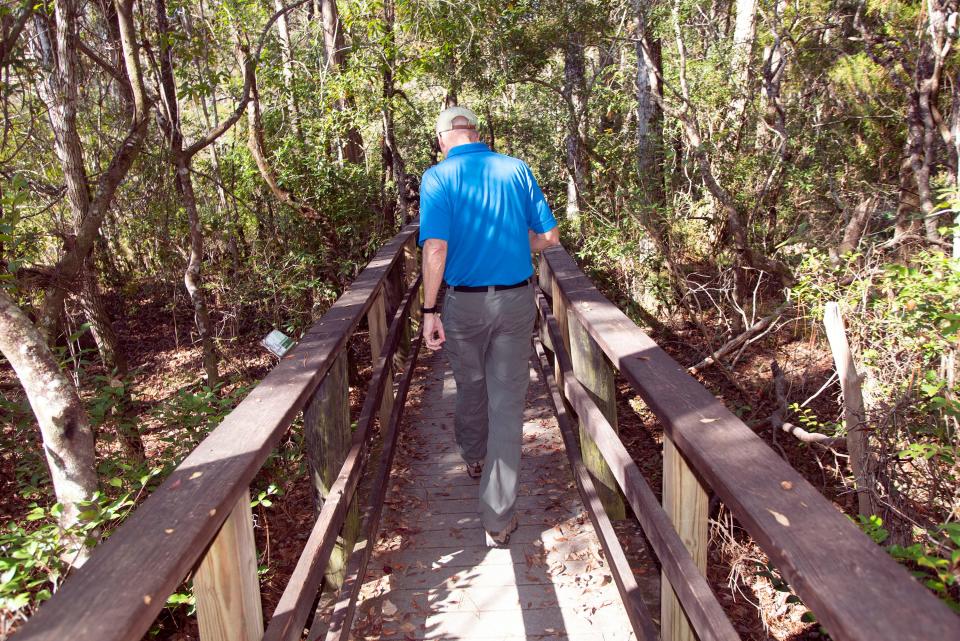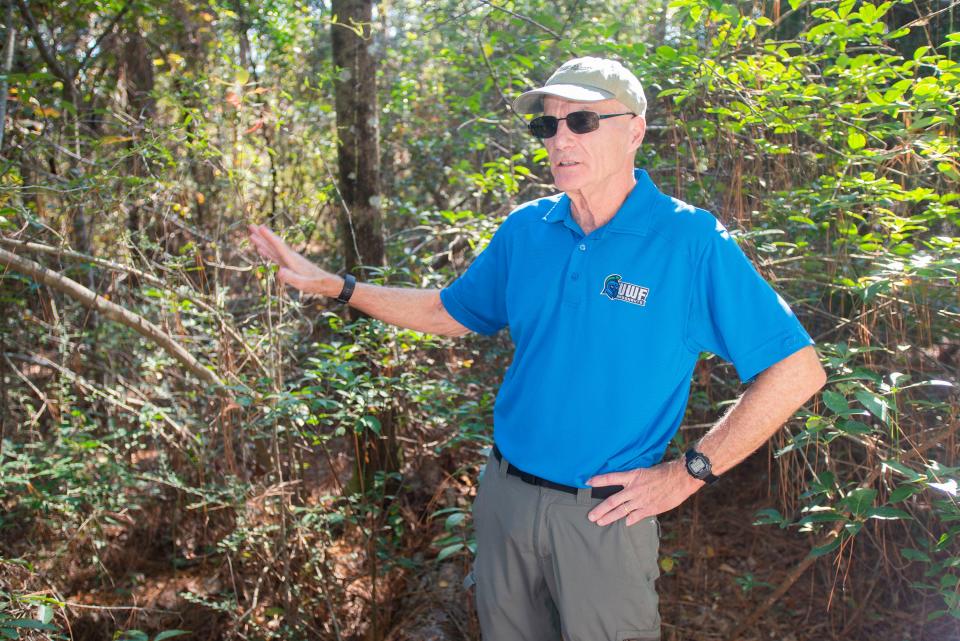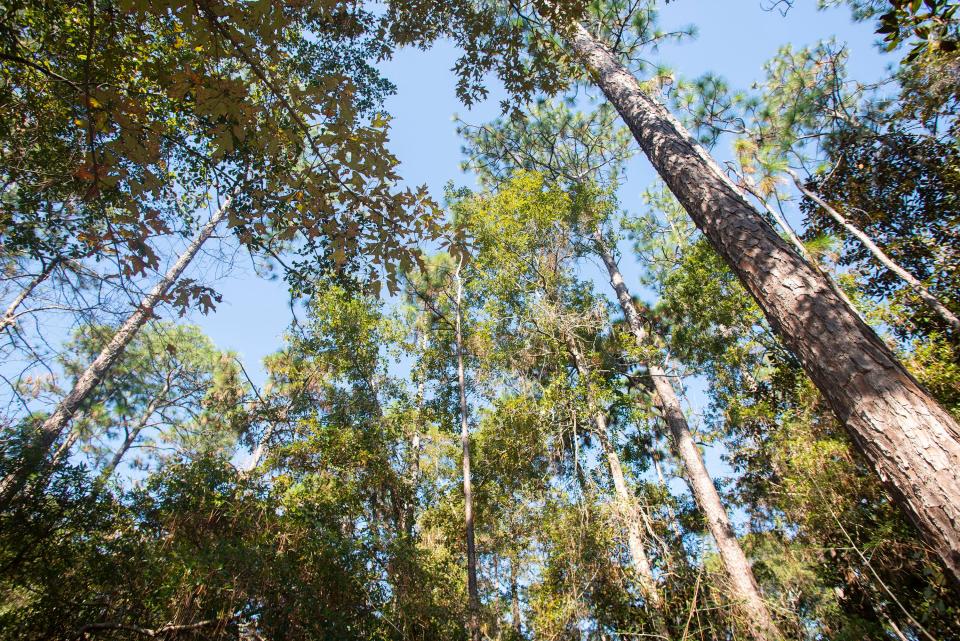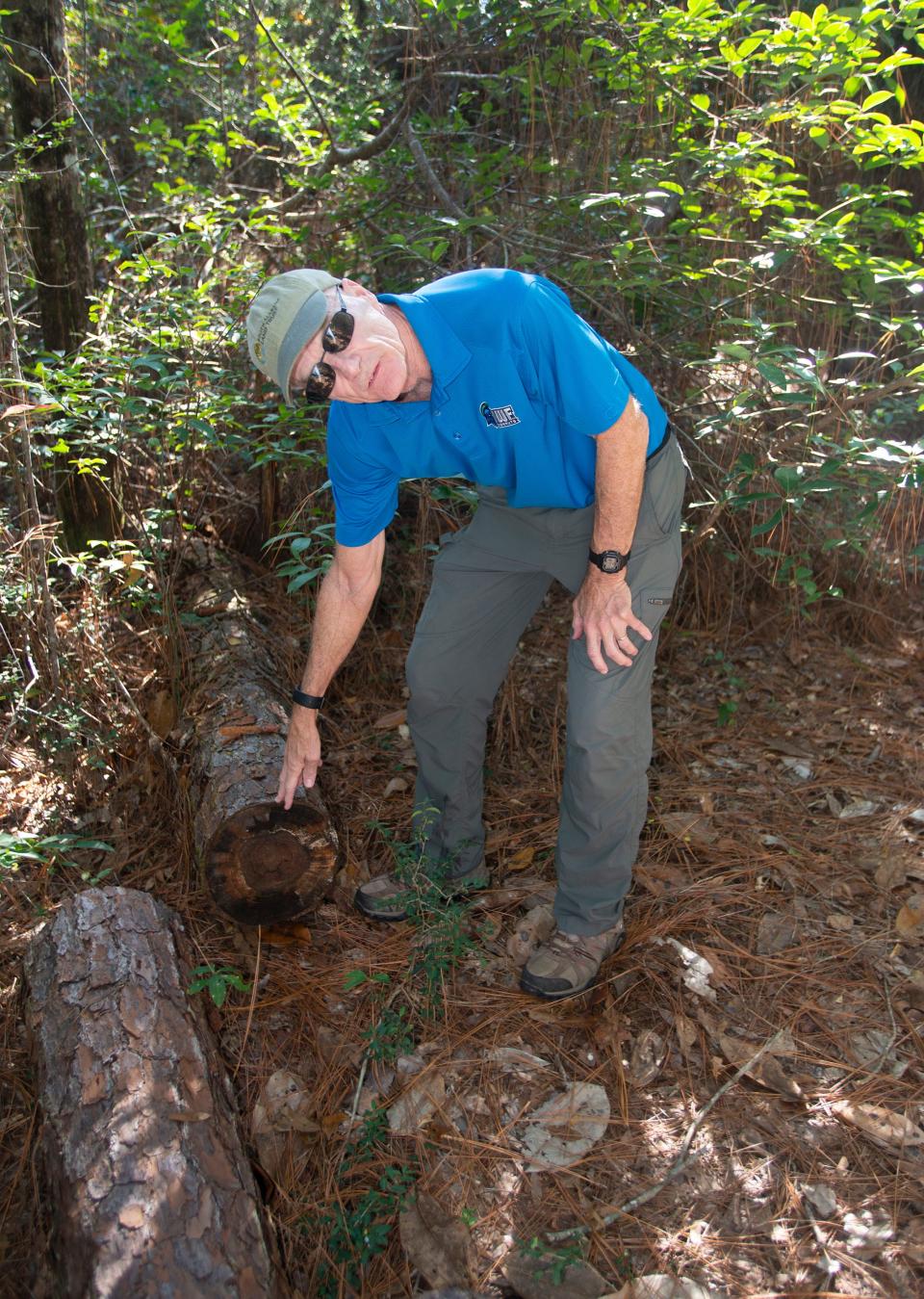UWF's Pensacola campus is a unique ecosystem. This professor works to protect and study it
It was a simple walk across the University of West Florida's manicured campus that brought Professor Frank Gilliam to what might be considered a professional epiphany.
"I was amazed, especially by the trees. And most especially by the longleaf pines," he said. "The campus had me at 'longleaf.'”
A plant ecologist fascinated by the world around him and an educator with a passion for working with students, Gilliam saw as he looked around him a unique ecosystem worthy of study, and an opportunity for ground-breaking research in his own backyard.
Thus the UWF Campus Ecosystem Study was born.
"What we're doing on our campus is a really cool thing," he said. "We're doing research about the campus, on the campus."

State of the University: President Saunders spent 6 years cultivating her vision for UWF. It's all coming together
More campus news: Pensacola law firm gives $2.5 million to new UWF leadership center
Working with approximately 11 students, Gilliam has, since 2020, published four studies centered on the UWF ecosystem. They have thus far focused primarily on the habitat of the long leaf pine and the gopher tortoise, two species that play a unique and vital role in shaping and maintaining a uniquely southern ecosystem. Another manuscript is in the works, based on research conducted this summer.
Each study is designed to build upon the findings of those conducted before it.
Since joining the university staff in 2018, Gilliam said he has developed a profound appreciation for John E. Jarvis, the man responsible for designing the UWF campus. He's gone so far as to call for a fellowship to be established Jarvis's name.
Jarvis, whose work was heavily influenced by a Scottish landscape architect named Ian McHarg, the author of a groundbreaking novel titled "Design with Nature," envisioned a UWF campus on which the ecological features of its grounds were maintained and celebrated.
"This not only included minimizing the cutting of trees, but also maintaining as much of the original contour as possible while creating buildings and paved areas, including roads, sidewalks, and parking lots," Gilliam wrote as part of his original scientific paper.
The decline of the longleaf pine
Within the campus design, Gilliam saw that one feature stood out among the others.
"Of the native species of trees the most prominent, in terms of physical stature, frequency and density," he wrote, "is the longleaf pine."

Longleaf pine forests once covered an estimated 90 million acres of the southeastern United States, but the trees were considered a perfect timber product for use in home construction. Harvesting, urbanization and even the successful prevention of forest fires decimated the longleaf to the point it is now estimated less than 3% of the original number still stand.
Gilliam's first ecosystem study revolved around counting the longleaf pines on the UWF campus and estimating the age of each tree. During the summer of 2019, students fanned out across the college property, located 2,165 longleaf pines and took measurements. Their work provided the information needed to conclude at that time that 80% of the college's trees were between 50 and 125 years old, with the oldest just under 200 years.
Those calculations were later rethought and revised, though, as part of another study undertaken by Gilliam and his students following Hurricane Sally.
The hurricane did significant damage to the UWF campus and knocked down many trees. Limbs and trunks of damaged longleaf pine in areas frequented by student and staff were removed for safety reasons after the storm, but Gilliam was able to access trees that had fallen victim to "hurricane-induced windthrows" along a nature trail and within the confines of a wildlife sanctuary built into the college design plan.
The study group took core samples from 50 trees and deployed sophisticated methods to calculate the ages of the trees. They used the information gathered from the fallen trees to extrapolate the ages of those still standing on the college grounds.
"The oldest longleaf pines are (approximately) 130 years old" with an average age of about 64, the updated findings showed.
Gilliam said the age findings were significant because they showed the UWF longleaf population to be younger than originally thought and, as he reported following the study, "consistent with cessation of historically widespread harvesting in the region."
Another key finding using the same data set is that heat tends to slow the growth of the longleaf pine, which came as something of a surprise and, Gilliam noted, could prove detrimental to the tree's survival in a world being impacted by climate change.
Longleafs, fire and tortoises
The longleaf studies were run alongside studies of the gopher tortoise, an "ecosystem engineer species" whose population, because it needs open spaces to live, is confined at UWF primarily to utility right of ways that run just off the nature trails.
A primary finding regarding the turtles is that as it burrows into the soil, the gopher tortoise significantly improves the quality of the soil around its den, and such improvements helps sustain plant life.
The long leaf pine and the gopher tortoise have for centuries shared environments that included not only the open spaces favored by both species, but also one impacted on a fairly regular basis by fire. The fires have traditionally tended to remove a lot of the undergrowth that hasn't adapted a resistance to it, as the long leaf has.

One of Gilliam's studies, undertaken in 2021, sought to determine the impact of "chronic fire exclusion" on the local long leaf population.
On a college campus in an urban setting, controlled burns like those employed at the vast Eglin Air Force Base reservation to maintain its longleaf pine population are not an option. Gilliam estimated that some of UWF's longleaf populations haven't been exposed to fire in a century or more.
Gilliam found that even without fire, the longleaf pine population can thrive and regenerate itself in open areas like those the gopher tortoises occupy. But no expansion of either species is occurring within the dark, densely vegetated areas along the hiking trails that have served as his laboratory.
The study group also looked at trees growing on the campus proper. Gilliam noted that while regular mowing around the longleaf pines thwarted competition from oaks and other hardwoods, it also prevented the regeneration of the population because not only are seedlings being prevented from taking root in the grass beneath the pines, but the cones that carry the seed to ground are regularly removed from the campus property.
That means that what trees exist now on the campus proper are, under present circumstances, the last of their kind.
"Although this may appear to bode poorly for the future of longleaf at UWF, longleaf pine is a long-lived species with some living for more than 400 years," the findings of the 2021 study said. "Thus it is likely in the absence of major disturbances these pines should remain a prominent part of the campus landscape well into the distant future."
Connecting UWF's campus with the community
Gilliam went on to recommend as part of the study that the college seek to increase the longleaf pine population by clearing areas around the stands where it grows on campus to allow for "open places within campus lawns to create opportunities for cone deposition/accumulation and seed germination."
"Not only could these patches be protected from human intervention with small fences, but educational signage could be added to inform interested individuals about the life cycle of the tree species that once dominated the Southeastern United States," the study states in the form of a recommendation.
Gilliam said college administrators are yet to act upon the recommendation.
Gilliam's most recent undertaking involved studying water quality on Thompson Bayou, a waterway that winds through "a combination of commercial and residential properties, including a golf course" before finding its way onto the UWF campus. It exits the campus a short time before flowing into the Escambia River a short distance from the Gulf of Mexico.
The one-year study, during which students regularly tested water at eight locations on the bayou, found evidence that wetlands the bayou passes through as it enters the UWF grounds do a tremendous job of filtering sediments, nutrients and debris. Research also indicated positive influences on the waterway as it flowed through on-campus "upland forest stands."

Evidence of the health of Thompson Bayou is bolstered by the presence of healthy fish and turtle populations and the presence of at least one alligator, Gilliam said.
Though he has struggled to gain full support from the UWF hierarchy, Gilliam said the students involved in the UWF Campus Ecosystem Study are "super excited" to play a role in documenting findings "read all over the world."
And with strong support from Jaromy Kuhl, the dean of his department, Gilliam has proposed expanding the scope of his work. In a memo he recommended promoting on-campus awareness of campus ecology, reaching out to the Pensacola community, extending aquatic research, and publishing a book that highlights the unique ecology of the University of West Florida.
Gilliam said he had met with Mark Jackson, the city of Pensacola's sustainability coordinator, and Kristopher Stultz, the city's arborist.
"We talked about establishing connections between the city of Pensacola and UWF. We especially focused on both paid and volunteer internships for UWF students to assist with the city's efforts to quantify (identify, measure, etc.) trees in the various parks," he said in a Friday email. "We also discussed the possibility of UWF employing some of the city's technology for on-campus trees."
He also envisions welcoming students from Title 1 schools onto the UWF campus to walk its nature trails and learn about an environment many of them have had little to no exposure to.
"The idea is to connect the campus more closely with the community," he said.
This article originally appeared on Pensacola News Journal: University of West Florida professor studying campus longleaf pines

